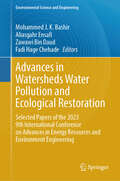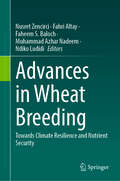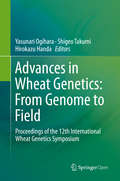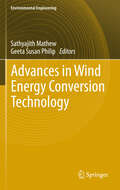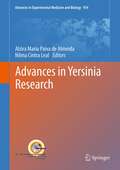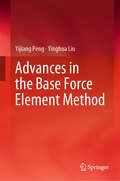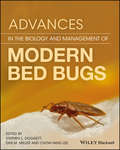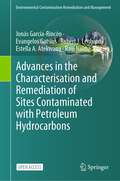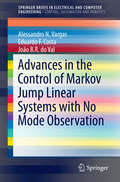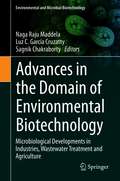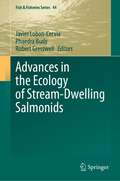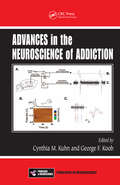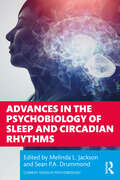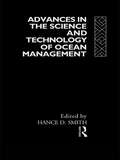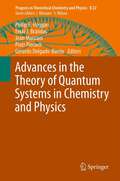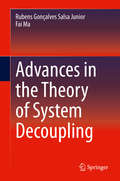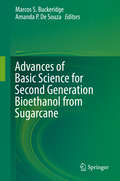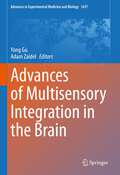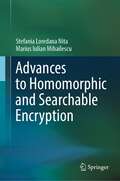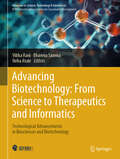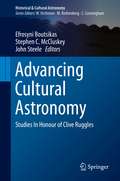- Table View
- List View
Advances in Watersheds Water Pollution and Ecological Restoration: Selected Papers of the 2023 9th International Conference on Advances in Energy Resources and Environment Engineering (Environmental Science and Engineering)
by Fadi Hage Chehade Zawawi Bin Daud Mohammed J. K. Bashir Aliasgahr EnsafiThis book provides a glimpse into the cutting-edge research on pollution management and detection in the water environments of watersheds, covering topics like water pollution traceability, pollution monitoring, and management techniques. According to the United Nations World Water Development Report provided by the World Water Forum, millions of tons of garbage are dumped into rivers, lakes, and streams around the world every day, and every liter of wastewater pollutes eight liters of freshwater, causing a serious damage to the water environment in watersheds. The protection and prevention of water in watersheds, which is related to freshwater resources for human development and survival, has always been a crucial research direction in the field of environmental engineering. This book aims to promote the exchange of scientific information among scholars from the world's leading universities, research centers, and high-tech companies and is of great benefit to researchers and professionals in the field of environmental control of watershed management.
Advances in Welding Technologies for Process Development
by Jaykumar Vora Vishvesh J. BadhekaWithin manufacturing, welding is by far the most widely used fabrication method used for production, leading to a rise in research and development activities pertaining to the welding and joining of different, similar, and dissimilar combinations of the metals. This book addresses recent advances in various welding processes across the domain, including arc welding and solid-state welding process, as well as experimental processes. The content is structured to update readers about the working principle, predicaments in existing process, innovations to overcome these problems, and direct industrial and practical applications. Key Features: Describes recent developments in welding technology, engineering, and science Discusses advanced computational techniques for procedure development Reviews recent trends of implementing DOE and meta-heuristics optimization techniques for setting accurate parameters Addresses related theoretical, practical, and industrial aspects Includes all the aspects of welding, such as arc welding, solid state welding, and weld overlay
Advances in Wheat Breeding: Towards Climate Resilience and Nutrient Security
by Nusret Zencirci Faheem S. Baloch Fahri Altay Muhammad Azhar Nadeem Ndiko LudidiThis edited book addresses the introduction to wheat, advancements in breeding, the contribution of biotechnological approaches, the development of climate-resilient wheat cultivars, and biofortification efforts to create nutrient-rich wheat cultivars.The world faces simultaneous challenges of a growing population and climate change. It is anticipated that the world population will exceed 9 billion by 2050. Meanwhile, climate change significantly impacts agriculture through uneven patterns, expected to worsen in the coming years, resulting in substantial losses due to biotic and abiotic stresses. Wheat, a staple food for millions worldwide, requires more studies to develop climate-resilient cultivars with improved nutritional content. Given these considerations, it is crucial to understand the activities conducted for wheat breeding and address the current gap to ensure an ample food supply for future generations.This book is beneficial for researchers, teachers, agriculturists, biologists, climate change scientists, and organizations involved in wheat breeding. It also serves as a valuable resource for undergraduate, master, and PhD students interested in wheat.
Advances in Wheat Genetics: Proceedings of the 12th International Wheat Genetics Symposium
by Yasunari Ogihara Shigeo Takumi Hirokazu HandaThis proceedings is a collection of 46 selected papers that were presented at the 12th International Wheat Genetics Symposium (IWGS). Since the launch of the wheat genome sequencing project in 2005, the arrival of draft genome sequences has marked a new era in wheat genetics and genomics, catalyzing rapid advancement in the field. This book provides a comprehensive review of the forefront of wheat research, across various important topics such as germplasm and genetic diversity, cytogenetics and allopolyploid evolution, genome sequencing, structural and functional genomics, gene function and molecular biology, biotic stress, abiotic stress, grain quality, and classical and molecular breeding. Following an introduction, 9 parts of the book are dedicated to each of these topics. A final, 11th part entitled "Toward Sustainable Wheat Production" contains 7 excellent papers that were presented in the 12th IWGS Special Session supported by the OECD. With rapid population growth and radical climate changes, the world faces a global food crisis and is in need of another Green Revolution to boost yields of wheat and other widely grown staple crops. Although this book focuses on wheat, many of the newly developed techniques and results presented here can be applied to other plant species with large and complex genomes. As such, this volume is highly recommended for all students and researchers in wheat sciences and related plant sciences and for those who are interested in stable food production and food security.
Advances in Wind Energy Conversion Technology (Environmental Science and Engineering)
by Geeta Susan Philip Mathew SathyajithWith an annual growth rate of over 35%, wind is the fastest growing energy source in the world today. As a result of intensive research and developmental efforts, the technology of generating energy from wind has significantly changed during the past five years. The book brings together all the latest aspects of wind energy conversion technology - right from the wind resource analysis to grid integration of the wind generated electricity. The chapters are contributed by academic and industrial experts having vast experience in these areas. Each chapter begins with an introduction explaining the current status of the technology and proceeds further to the advanced lever to cater for the needs of readers from different subject backgrounds. Extensive bibliography/references appended to each chapter give further guidance to the interested readers.
Advances in Yersinia Research (Advances in Experimental Medicine and Biology #954)
by Alzira Maria de Almeida Nilma Cintra LealThis book is a collection of articles written by prominent scientists who gathered in the city of Recife, Brazil, 23-27 October 2010, celebrating the 10th International Symposium on Yersinia. The event is held every four years in a different country and for the Yersinia 2010, an interesting and updated program covering advances in research in Yersiniae was organized. The major advances achieved over the past four years since the last symposium held in Lexington, USA in 2006 were divided into eight chapters: Epidemiology, Clinical, Diagnostic and Therapeutic aspects; Ecology and Modeling; Genomic/Transcriptomics and Large Scale Population; Immune Response and Vaccine; Pathogenesis and Pathogenicity Factors; Cellular Yersiniology; Bacterial Structure and Metabolism: Roles in Pathogenesis and Bacterial Life Style. The purpose of the book is to extend cutting edge knowledge on Yersinia discussed during the 10th International Symposium.
Advances in the Base Force Element Method
by Yijiang Peng Yinghua LiuThis book describes the main concepts of and recent advances in the base forces element method (BFEM). It combines theories, methods, models, numerical results, and an analysis of the BFEM. Each chapter starts with an introduction and derivation of a new mathematical model for the proposed method. Subsequently, the methods are described and numerical examples demonstrating the significance of the proposed method are presented. The closing chapter summarizes the performance and features of the BFEM and describes the prospects for its application. The book is intended for engineers, scientists and graduate students in applied mechanics and applied mathematics, and for all readers interested in numerical computations and simulations.
Advances in the Biology and Management of Modern Bed Bugs
by Stephen L. Doggett Dini M. Miller Chow-Yang LeeThe first comprehensive scholarly treatment of bed bugs since 1966 This book updates and expands on existing material on bed bugs with an emphasis on the worldwide resurgence of both the common bed bug, Cimex lectularius L., and the tropical bed bug, Cimex hemipterus (F.). It incorporates extensive new data from a wide range of basic and applied research, as well as the recently observed medical, legal, and regulatory impacts of bed bugs. Advances in the Biology and Management of Modern Bed Bugs offers new information on the basic science and advice on using applied management strategies and bed bug bioassay techniques. It also presents cutting-edge information on the major impacts that bed bugs have had on the medical, legal, housing and hotel industries across the world, as well as their impacts on public health. Advances in the Biology and Management of Modern Bed Bugs offers chapters that cover the history of bed bugs; their global resurgence; their impact on society; their basic biology; how to manage them; the future of these pests; and more. Provides up-to-date information for the professional pest manager on bed bug biology and management Features contributions from 60 highly experienced and widely recognized experts, with 48 unique chapters A one-stop-source that includes historic, technical, and practical information Serves as a reference book for academic researchers and students alike Advances in the Biology and Management of Modern Bed Bugs is an essential reference for anyone who is impacted by bed bugs or engaged in managing bed bugs, be it in an academic, basic or applied scientific setting, or in a public outreach, or pest management role, worldwide.
Advances in the Characterisation and Remediation of Sites Contaminated with Petroleum Hydrocarbons (Environmental Contamination Remediation and Management)
by Ravi Naidu Jonás García-Rincón Evangelos Gatsios Robert J. Lenhard Estella A. AtekwanaThis open access book synthesizes important advances in the assessment and management of soil and groundwater systems contaminated with petroleum hydrocarbons, especially in the form of light non-aqueous phase liquids (LNAPLs). LNAPL characterization and remediation is challenging due to the multi-phase, multi-component nature of the problem and the various physical, chemical, and biological processes involved in a dynamic and heterogeneous hydrogeological setting. This book focuses on the current state of practice of LNAPL characterization and remediation and seeks to provide information and a framework that would allow some of these complexities to be better addressed by contaminated land practitioners, researchers, and regulators.
Advances in the Control of Markov Jump Linear Systems with No Mode Observation (SpringerBriefs in Electrical and Computer Engineering)
by Alessandro N. Vargas Eduardo F. Costa João B. R. do ValThis brief broadens readers' understanding of stochastic control by highlighting recent advances in the design of optimal control for Markov jump linear systems (MJLS). It also presents an algorithm that attempts to solve this open stochastic control problem, and provides a real-time application for controlling the speed of direct current motors, illustrating the practical usefulness of MJLS. Particularly, it offers novel insights into the control of systems when the controller does not have access to the Markovian mode.
Advances in the Diagnosis and Treatment of Sleep Apnea: Filling the Gap Between Physicians and Engineers (Advances in Experimental Medicine and Biology #1384)
by Thomas Penzel Roberto HorneroThe book focuses on biomedical innovations related to the diagnosis and treatment of sleep apnea. The latest diagnostic tools are described, including sleep laboratory equipment, wearables, and even smartphone apps. Innovative medical devices for treatment are also covered, such as CPAP, Auto-PAP, hypoglossal nerve stimulation, phrenic nerve stimulation, acoustic brain stimulation and electrical brain stimulation. This is an ideal book for biomedical engineers, pneumologists, neurologists, cardiologists, physiologists, ENT physicians, pediatrics, and epidemiologists who are interested in learning about the latest technologies in treating and diagnosing sleep apnea.
Advances in the Domain of Environmental Biotechnology: Microbiological Developments in Industries, Wastewater Treatment and Agriculture (Environmental and Microbial Biotechnology)
by Naga Raju Maddela Luz C. García Cruzatty Sagnik ChakrabortyThis book complies latest advancement in the field of environmental biotechnology. It focuses on topics that comprises industrial, environment and agricultural related issues to microbiological studies and exhibits correlation between biological world and dependence of humans on it. It is designed into three sections covering the role of environmental biotechnology in industry, environmental remediation, and agriculture. Ranging from micro-scale studies to macro, it covers up a huge domain of environmental biotechnology. Overall the book portrays the importance of modern biotechnology technologies in solving the problems in modern day life. The book is a ready reference for practicing students, researchers of biotechnology, environmental engineering, chemical engineering and other allied fields likewise.
Advances in the Ecology of Stream-Dwelling Salmonids (Fish & Fisheries Series #44)
by Javier Lobon-Cervia Phaedra Budy Robert GresswellMany salmonids inhabit streams during the whole, or a substantial part of their lifetime. Streams, as networks of cold waters running over rifles, pools and tables of gravel, pebble and stony substratum, are fed by rainfall and snowmelt and may be subject to spates and droughts. Hence, these lotic systems are heterogeneous by nature and vary substantially in temperature and discharge along their environmental gradients. In these habitats, salmonids encounter suitable reproductive and feeding habitats where they exhibit a dizzying array of life‐history traits and an overwhelming variability in size, growth and density. Essentially predators upon organisms drifting across the water column, they become apex piscivores at large sizes. They may also serve as prey for aquatic macroinvertebrates at the youngest stages, and as they grow, they may become prey for birds and mammals. In addition, many populations play a major role in the recycling of biogeochemical elements critical for the trophic dynamics of their home streams. Empirical assessment of the ecological functioning of stream salmonids has been a tireless endeavor since the pioneer studies by Allen (1951), Chapman (1966), McFadden (1964) and Northcote (1966) further enhanced by the IBP (1964-1974; Gerking 1967) and extended to experimental approaches during the last decades (Northcote Lobon-Cervia 2010, Lobon-Cervia & Sanz 2017, Kershner et al. 2019). It has become increasingly apparent that streams are severely threatened by human abuse and misuse, including over-extraction, diversion, damming and pollution, in addition to the more recent threat of global warming. Furthermore, salmonids themselves are threatened by genetic introgressions, diseases, and parasites related to uncontrolled introductions of individuals from aquaculture, and over-exploitation by angling. These threats have triggered important social and political concerns, to the extent of becoming research priorities for major agenciesand institutions. In this context, we attempt to add an overview to this endeavor by updating and summarizing the documented ecology of stream-living salmonids, with reference to the factors and mechanisms underlying the growth, density and life history that interact to determine the size, number, and distribution of individuals encountered in any wild population.
Advances in the Neuroscience of Addiction (Frontiers in Neuroscience)
by George F. Koob Cynthia M. KuhnUnderstanding the phenomenon of long-lasting vulnerability to addiction is essential to developing successful treatments. Written by an international team of authorities in their respective fields, Advances in the Neuroscience of Addiction provides an excellent overview of the available and emerging approaches used to investigate the biologic mechanisms of drug addiction. It also delineates the promising research discoveries being made in relapse prevention.The book begins with current animal models of addiction, which mimic the state of humans entering treatment: recently-abstinent animals that receive common triggers for relapse (classical conditioning, stress, and neuroadaptive dysregulation). Coverage then shifts to the use of electrophysiologic approaches, which enable researchers to characterize the discharge patterns of single neurons during drug self-administration. After exploring advances in voltammetry and enzyme-linked biosensors for measuring glutamate, the book discusses the theoretical background and results of neuroimaging studies related to neuronal networks that are activated by drug-specific cues. It then describes modern genetic approaches to manipulate target proteins that influence addictive behavior.The book rounds out its coverage by illustrating how a neuroeconomic approach can inform studies of reward processing in general and addiction in particular. It is a comprehensive introduction to the methodologies of the field for students and beginning researchers and an essential reference source for established investigators.
Advances in the Psychobiology of Sleep and Circadian Rhythms (Current Issues in Psychobiology)
by Melinda L. Jackson Sean P.A. DrummondAdvances in the Psychobiology of Sleep and Circadian Rhythms features international experts from the fields of psychobiology, sleep research and chronobiology to address and review cutting-edge scientific literature concerning recent advances in the psychobiology of sleep, sleep disorders, such as sleep apnoea and insomnia, and circadian rhythms, across the lifespan. In this illuminating volume, Melinda L. Jackson and Sean P.A. Drummond bring together leading international researchers to review cross-cutting issues in the field, including sleep and pain, sleep and dementia risk, and sleep issues in paediatric populations as well as the interaction between sleep and health conditions in different populations. The chapters offer coverage of the major explanatory models which underpin the empirical work as well as a discussion of the relevant theoretical and conceptual models on issues arising with specific psychiatric and medical disorders, including depression, dementia, posttraumatic stress disorder and pain. They also address new research in the area of chronobiology, and circadian impacts on health and diseases. The chapters also discuss important methodological and ethical issues arising in research and include sections addressing implications for public policy and practitioner interventions in the context of different social and cultural environments. This volume will be a crucial resource for professionals, practitioners and researchers engaged in the field as well as for postgraduate and upper-level undergraduate students undertaking research in areas related to psychobiology, neuropsychology, health psychology and other disciplines such as biology, physiology and psychopharmacology.
Advances in the Science and Technology of Ocean Management (Routledge Advances in Maritime Research)
by Hance SmithThis book reviews key developments in the field of marine science and technology. It focuses on three major themes such as the importance of technical developments in ocean management, the application of these developments to specific sea uses ranging from fish farming to the disposal of industrial waste, and the long-term issues that such developments raise.
Advances in the Theory of Quantum Systems in Chemistry and Physics: Conceptual And Computational Advances In Quantum Chemistry (Progress in Theoretical Chemistry and Physics #22)
by Jean Maruani Erkki J. Brändas Gerardo Delgado-Barrio Piotr Piecuch Philip E. HogganAdvances in the Theory of Quantum Systems in Chemistry and Physics is a collection of 32 selected papers from the scientific contributions presented at the 15th International Workshop on Quantum Systems in Chemistry and Physics (QSCP-XV), held at Magdalene College, Cambridge, UK, from August 31st to September 5th, 2010. This volume discusses the state of the art, new trends, and the future of methods in molecular quantum mechanics and their applications to a wide range of problems in chemistry, physics, and biology. The breadth and depth of the scientific topics discussed during QSCP-XV are gathered in seven sections: I. Fundamental Theory; II. Model Atoms; III. Atoms and Molecules with Exponential-Type Orbitals; IV. Density-Oriented Methods; V. Dynamics and Quantum Monte-Carlo Methodology; VI. Structure and Reactivity; VII. Complex Systems, Solids, Biophysics. Advances in the Theory of Quantum Systems in Chemistry and Physics is written for research students and professionals in Quantum systems of chemistry and physics. It also constitutes and invaluable guide for those wishing to familiarize themselves with research perspectives in the domain of quantum systems for thematic conversion or simply to gain insight into the methodological developments and applications to physics chemistry and biology that have actually become feasible by the end of 2010.
Advances in the Theory of System Decoupling
by Rubens Gonçalves Salsa Junior Fai MaThis book presents a concise, clear, and consistent account of the methodology of phase synchronization, an extension of modal analysis to decouple any linear system in real space. It expounds on the novel theory of phase synchronization and presents recent advances, while also providing relevant background on classical decoupling theories that are used in structural analysis. The theory is illustrated with a broad range of examples. The theoretical development is also supplemented by applications to engineering problems. In addition, the methodology is implemented in a MATLAB algorithm which can be used to solve many of the illustrative examples in the book. This book is suited for researchers, practicing engineers, and graduate students in various fields of engineering, mathematics, and physical science.
Advances in the Understanding of Biological Sciences Using Next Generation Sequencing (NGS) Approaches
by Sunil Kumar Gaurav Sablok Saneyoshi Ueno Jimmy Kuo Claudio VarottoProvides a global view of the recent advances in the biological sciences and the adaption of the pathogen to the host plants revealed using NGS. Molecular Omic's is now a major driving force to learn the adaption genetics and a great challenge to the scientific community, which can be resolved through the application of the NGS technologies. The availability of complete genome sequences, the respective model species for dicot and monocot plant groups, presents a global opportunity to delineate the identification, function and the expression of the genes, to develop new tools for the identification of the new genes and pathway identification. Genome-wide research tools, resources and approaches such as data mining for structural similarities, gene expression profiling at the DNA and RNA level with rapid increase in available genome sequencing efforts, expressed sequence tags (ESTs), RNA-seq, gene expression profiling, induced deletion mutants and insertional mutants, and gene expression knock-down (gene silencing) studies with RNAi and microRNAs have become integral parts of plant molecular omic's. Molecular diversity and mutational approaches present the first line of approach to unravel the genetic and molecular basis for several traits, QTL related to disease resistance, which includes host approaches to combat the pathogens and to understand the adaptation of the pathogen to the plant host. Using NGS technologies, understanding of adaptation genetics towards stress tolerance has been correlated to the epigenetics. Naturally occurring allelic variations, genome shuffling and variations induced by chemical or radiation mutagenesis are also being used in functional genomics to elucidate the pathway for the pathogen and stress tolerance and is widely illustrated in demonstrating the identification of the genes responsible for tolerance in plants, bacterial and fungal species.
Advances of Basic Science for Second Generation Bioethanol from Sugarcane: Bioethanol From Sugarcane And Their Impact On Technology
by Marcos S. Buckeridge Amanda P. De SouzaThis book focuses on the basic science recently produced in Brazil for the improvement of sugarcane as a bioenergy crop and as a raw material for 2nd generation bioethanol production. Part I details the development of some of the most important basic scientific tools needed for 2nd generation technologies of sugarcane in the domains of plant physiology and agricultural sciences and the domains of chemistry and biochemistry of plants and microorganisms. These include issues such as plant cell wall structure and architecture, physical characteristics of sugarcane biomass that are to be used for hydrolysis and fermentation in 2nd generation processes. Part II focuses on the development of the more applied sciences necessary to advance technological processes of pretreatment and hydrolysis of biomass and fermentation of the free sugars released from it. Some aspects of enzyme engineering are approached in this session and ends with a proposition of the assembly of an enzymatic cocktail based on the discoveries made by INCT-Bioethanol researchers after discovery of new enzymes among the Brazilian biodiversity of microorganisms. Part III examines the issue of how some key elements of basic science (Part I) have be applied to develop technologies for 2nd generation bioethanol (Part II). The translation from basic to applied sciences is highlighted as key for innovation using examples based on recent case studies in the area. In Part IV, a discussion about how policies that interconnect the scientific communities among scientists and the society in general of countries can help to accelerate or decelerate technological development depending on how efficient is communication among scientists, policy makers and industry.
Advances of Multisensory Integration in the Brain (Advances in Experimental Medicine and Biology #1437)
by Yong Gu Adam ZaidelThis book presents the latest research on multisensory brain function. Namely, the mechanisms by which the brain processes and integrates information from multiple sensory modalities. Its contents cover a broad range of topics, including optimal integration, cross-modal interactions, calibration, and causal inference – with an emphasis on their neuronal underpinnings. By bringing together efforts from different laboratories around the world we aim to collaboratively shed light on these fundamental brain processes, that underlie perception, cognition, and behavior in a complex multisensory world, and to spur innovation of brain-inspired technologies
Advances on Intelligent Informatics and Computing: Health Informatics, Intelligent Systems, Data Science and Smart Computing (Lecture Notes on Data Engineering and Communications Technologies #127)
by Faisal Saeed Fathey Mohammed Fuad GhalebThis book presents emerging trends in intelligent computing and informatics. This book presents the papers included in the proceedings of the 6th International Conference of Reliable Information and Communication Technology 2021 (IRICT 2021) that was held virtually, on Dec. 22-23, 2021. The main theme of the book is “Advances on Intelligent Informatics and Computing”. A total of 87 papers were submitted to the conference, but only 66 papers were accepted and published in this book. The book presents several hot research topics which include health informatics, artificial intelligence, soft computing, data science, big data analytics, Internet of Things (IoT), intelligent communication systems, cybersecurity, and information systems.
Advances to Homomorphic and Searchable Encryption
by Stefania Loredana Nita Marius Iulian MihailescuThis book presents the current state of the literature on the fields of homomorphic and searchable encryption, from both theoretical and practical points of view. Homomorphic and searchable encryption are still relatively novel and rapidly evolving areas and face practical constraints in the contexts of large-scale cloud computing and big data.Both encryption methods can be quantum-resistant if they use the right mathematical techniques. In fact, many fully homomorphic encryption schemes already use quantum-resistant techniques, such as lattices or characteristics of polynomials – which is what motivated the authors to present them in detail.On the one hand, the book highlights the characteristics of each type of encryption, including methods, security elements, security requirements, and the main types of attacks that can occur. On the other, it includes practical cases and addresses aspects like performance, limitations, etc. As cloud computing and big data already represent the future in terms of storing, managing, analyzing, and processing data, these processes need to be made as secure as possible, and homomorphic and searchable encryption hold huge potential to secure both the data involved and the processes through which it passes.This book is intended for graduates, professionals and researchers alike. Homomorphic and searchable encryption involve advanced mathematical techniques; accordingly, readers should have a basic background in number theory, abstract algebra, lattice theory, and polynomial algebra.
Advancing Biotechnology: Technological Advancements in Biosciences and Biotechnology (Advances in Science, Technology & Innovation)
by Vibha Rani Bhawna Saxena Neha AtaleThis book offers the authors to share their opinion, news, research, reviews, and ideas on different aspects of biotechnology such as medical, plant biotechnology, food biotechnology, bioinformatic applications, systems biology, and biomedical engineering. World has witnessed the potential impact of biotechnology in various sectors. The ever-evolving nature of biotechnology and bioinformatics has resulted in an exponential increase in biotech entrepreneurship, industry-wide innovation, and development of novel technologies. Additionally, computational advancements including artificial intelligence, next generation sequencing, big data approaches, and complex algorithms have opened opportunities to understand the complex mechanisms and cellular behavior. The utility of this field has been appreciated worldwide; therefore, evaluating its applications, advancements, possibilities, challenges, ethics, and multidimensional utility will benefit scientific and non-scientific community for future applications.
Advancing Cultural Astronomy: Studies In Honour of Clive Ruggles (Historical & Cultural Astronomy)
by John Steele Efrosyni Boutsikas Stephen C. McCluskeyThis collection of essays on cultural astronomy celebrates the life and work of Clive Ruggles, Emeritus Professor of Archaeoastronomy at Leicester University. Taking their lead from Ruggles’ work, the papers present new research focused on three core themes in cultural astronomy: methodology, case studies, and heritage. Through this framework, they show how the study of cultural astronomy has evolved over time and share new ideas to continue advancing the field.Ruggles’ work in these areas has had a profound impact on the way that scholars approach evidence of the role of sky in both ancient and modern cultures. While the papers span many time periods and regions, they are closely connected by these three major themes, presenting methodological investigations of how we can approach archaeological, textual, and ethnographic evidence; describing detailed archaeoastronomical case studies; or stressing the importance of global heritage management.This work will appeal to researchers and scholars interested in the history and development of cultural astronomy.
